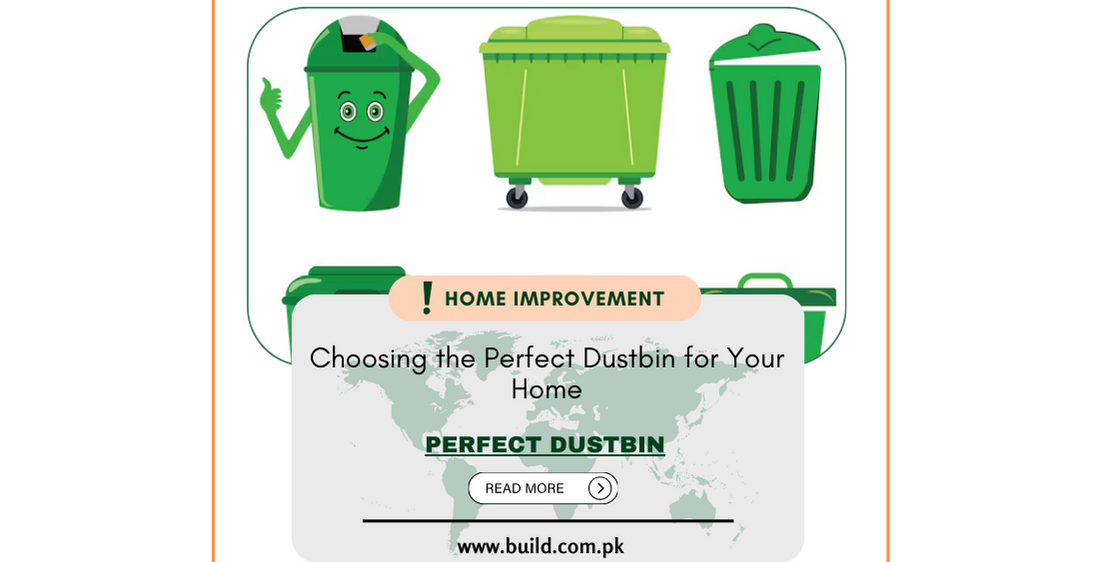Choosing the Perfect Dustbin for Your Home

Introduction:
A dustbin plays a vital role in maintaining cleanliness and
organization within your home, offering a convenient and hygienic solution for
waste disposal. With numerous options available on the market, selecting the
right dustbin requires thoughtful consideration of factors such as size,
material, lid type, and placement. In this detailed guide, we'll explore the
various types of dustbins, delve into key factors to consider when choosing
one, and provide practical tips for effective waste management.
Understanding the Basics
Before diving into the specifics of choosing a dustbin, it's
important to grasp the fundamental aspects of this essential household item:
Purpose: A dustbin, also known as a trash can or garbage bin,
is designed to collect and temporarily store household waste, including food
scraps, packaging, papers, and other disposable items.
Types: Dustbins come in diverse shapes, sizes, and materials,
each tailored to specific purposes and environments. From pedal bins to
swing-top bins and touchless bins, there's a wide range of options to suit
different preferences and needs.
Placement: Dustbins are typically positioned in key areas of
the home, including kitchens, bathrooms, bedrooms, and outdoor spaces, to
encourage proper disposal of waste and maintain cleanliness throughout the
living environment.
Types of Dustbins
Explore the variety of dustbin types available for
residential use, each offering unique features and benefits:
Pedal Bins:
Pedal bins, equipped with a foot pedal mechanism,
allow for hands-free operation by opening the lid when stepped on. This design
promotes hygiene and convenience, particularly in kitchen settings where hands
may be occupied with food preparation.
Swing Bins:
Also referred to as flip-top or swing-top bins,
these dustbins feature a hinged lid that swings open with a gentle push and
closes automatically after use. The swing lid design offers easy access to the
bin's contents without the need to lift a heavy lid.
Touchless Bins:
Modern touchless bins are equipped with motion
sensors that detect movement and automatically open the lid, making them
hygienic and ideal for minimizing contact with potentially germ-laden surfaces.
Recycling Bins:
Designed for sorting and collecting
recyclable materials such as paper, plastic, glass, and metal, recycling bins
help promote eco-friendly waste management practices within the home.
Compost Bins:
Compost bins are specifically intended for
collecting organic kitchen waste, such as fruit and vegetable peels, coffee
grounds, and eggshells, to facilitate the composting process and reduce
landfill waste.
Factors to Consider When Choosing a Dustbin
When selecting a dustbin for your home, take the following
factors into account to ensure optimal functionality and convenience:
Size:
Determine the appropriate size of the dustbin based on
the amount of waste generated by your household. A larger bin may be suitable
for the kitchen to accommodate food scraps and packaging, while smaller bins
may suffice for bathrooms or bedrooms.
Material:
Choose a dustbin made from durable and
easy-to-clean materials such as plastic, stainless steel, or aluminum. Consider
the aesthetic appeal and durability of the material to complement your home
decor and withstand daily use.
Lid Type:
Select a dustbin with a lid type that suits your
preferences and practical needs. Pedal bins offer hands-free operation, swing
bins provide easy access, and touchless bins ensure hygienic waste disposal
without direct contact.
Odor Control:
Look for dustbins with effective odor-sealing
features, such as tight-fitting lids or integrated deodorizing filters, to
prevent unpleasant smells from escaping and permeating the surrounding area.
Placement:
Consider where you intend to place the dustbin
within your home—indoors or outdoors, kitchen or bathroom, under the sink or in
a corner. Choose a compact design for smaller spaces and a robust design for
outdoor use to withstand weather conditions.
Tips for Effective Waste Management
Maximize the efficiency of your dustbin and maintain a clean
living environment with these practical waste management tips:
Use Liners: Line the dustbin with disposable liners or
reusable bags to facilitate easy removal of waste and minimize mess.
Regular Emptying: Empty the dustbin regularly to prevent
overflow and minimize odors. Establish a routine for waste disposal based on
your household's needs.
Separate Waste: Implement a recycling system by using
separate bins for different types of waste—general waste, recyclables, and
organic matter—to promote sustainable waste management practices.
Clean and Disinfect: Regularly clean and disinfect the
dustbin to eliminate germs and bacteria. Use mild detergent and water for
plastic bins, and a vinegar solution for stainless steel bins, to maintain
hygiene and freshness.
Conclusion:
In conclusion, choosing the perfect dustbin for your home involves careful consideration of various factors, including size, material, lid type, and placement, to meet your waste management needs effectively. By selecting the right dustbin and implementing smart waste management practices, you can maintain a clean, organized living environment while promoting sustainability and hygiene within your household. Take the time to explore different dustbin options and invest in a quality product that enhances the functionality and aesthetics of your home. With proper care and attention, your chosen dustbin will serve as an indispensable asset in keeping your living space clean, tidy, and welcoming for years to come. Happy dustbin shopping!









